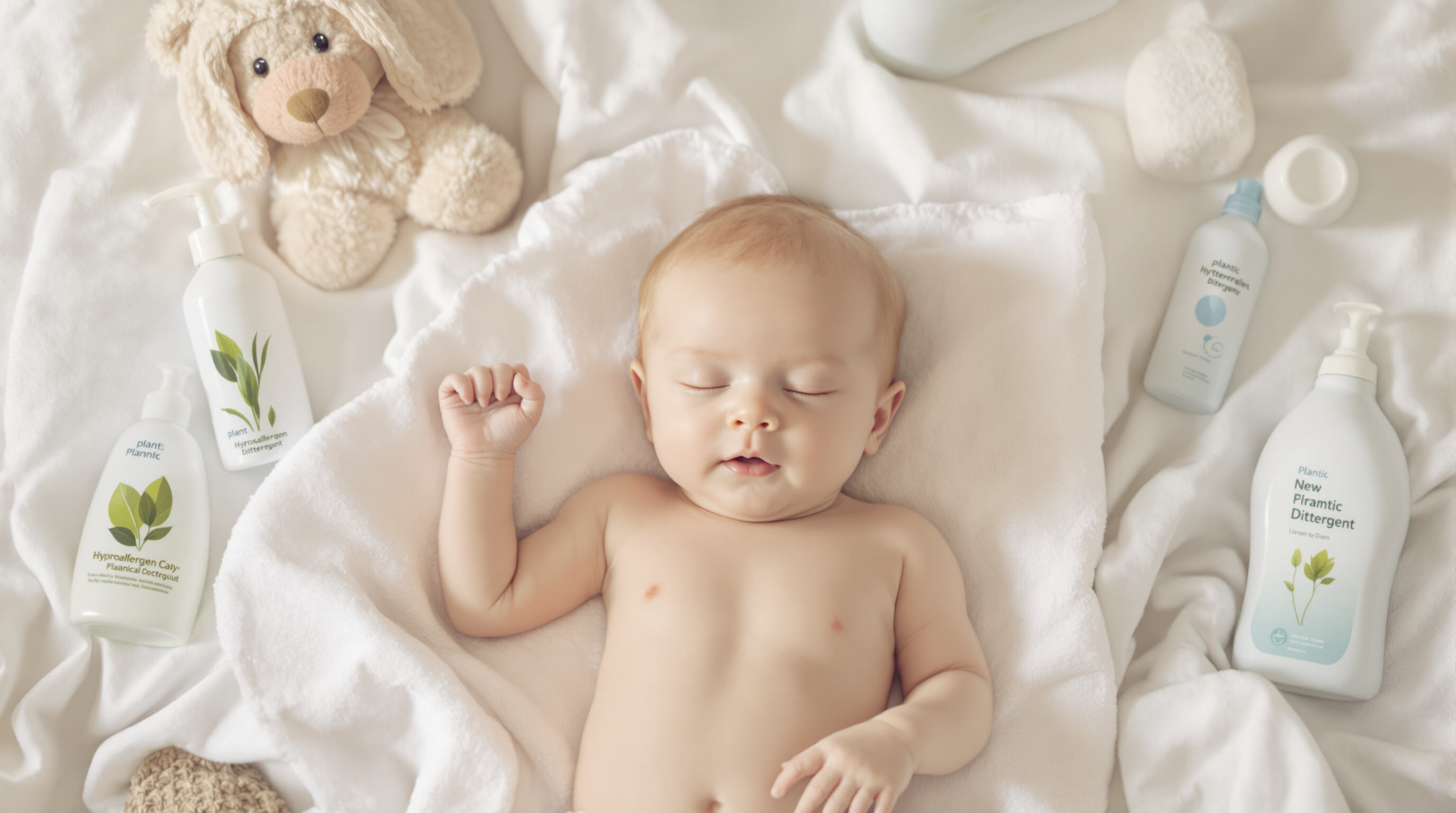Understanding How Detergents Affect Sensitive Skin
How Detergent Residues Affect Sensitive Skin
Laundry detergent residues trapped in fabrics create prolonged skin exposure to irritants. Surfactants like sodium lauryl sulfate (SLS) strip natural oils, leaving skin vulnerable to microscopic abrasions and dryness. Studies show that 32% of eczema flares are triggered by residual detergent particles (National Eczema Association, 2023).
Common Skin Reactions Caused by Laundry Detergent Chemicals
Irritant dermatitis and allergic contact dermatitis account for 78% of laundry-related skin complaints. Harsh surfactants disrupt pH balance, while synthetic fragrances activate immune responses in sensitive individuals. The National Eczema Association’s Seal of Acceptance sets rigorous benchmarks for excluding these reaction-causing agents.
The Role of Permeability in Skin Barrier Disruption
Compromised skin barriers allow detergent chemicals to penetrate 4x faster than healthy skin. Surfactants degrade stratum corneum lipids, increasing transepidermal water loss by up to 62% (Journal of Investigative Dermatology, 2022). This permeability cycle heightens sensitivity to environmental allergens.
Key Irritating Ingredients to Avoid in Detergent
Surfactants and Preservatives: Hidden Triggers for Sensitive Skin
Common surfactants found in many cleansers, such as sodium lauryl sulfate (SLS) and sodium laureth sulfate (SLES), actually remove natural oils from the skin which makes it more vulnerable to moisture loss and irritation problems. According to some recent research published last year in a dermatology journal, people with sensitive skin experience about 15 to maybe even 20 percent more cases of irritant contact dermatitis when exposed to these harsh chemicals because they basically wreck the protective skin barrier function. Another concern comes from preservatives like methylisothiazolinone (MI), which seems to be causing allergic reactions among roughly one out of every ten eczema sufferers we've seen in clinics. For folks looking to avoid all this trouble, there are now plenty of products on shelves that claim to be "surfactant free" or contain milder options such as decyl glucoside instead. These alternatives tend to be better tolerated by most skin types though results can vary depending on individual sensitivities.
Why Synthetic Fragrances and Dyes Worsen Skin Sensitivity
Many synthetic fragrances actually hide around 3,000 different chemicals inside them. Some common ones include limonene and linalool, substances that cause skin reactions for about 30% of people with sensitivities. A recent study from 2024 found that using detergents labeled as fragrance free cuts down on these problems by roughly two thirds. The same goes for certain dyes, especially D&C Blue No. 1, which can work its way through broken skin and make existing inflammation even worse. For those concerned about irritation, looking for products marked with the EPA's Safer Choice certification is probably a good idea since they've been tested to ensure they don't contain these problematic ingredients.
Phthalates, Formaldehyde Donors, and Optical Brighteners: Toxic Irritants Explained
Those sneaky phthalates hiding under the label "fragrance" mess with our hormone systems and studies show they can make eczema worse in kids by almost half. Then there's stuff like DMDM hydantoin which acts as a formaldehyde donor, basically releasing cancer-causing chemicals over time and leading to skin irritation plus breathing problems for many people. Optical brighteners stick to clothing fibers and just won't wash out properly, meaning we end up exposed to them again and again. When shopping around, it makes sense to check ingredient lists carefully and go for companies that actually tell us what goes into their products instead of keeping secrets behind vague terms like "parfum".
Are “Natural” Fragrances Safer? Debunking the Myth
So called "natural" scents made from essential oils like lavender or citrus actually pack between 40 to 60 potential allergens in each product formulation, as found in research published last year. Take bergamot oil for example it can lead to serious skin reactions if someone gets sun exposure after applying it. Products that are genuinely safe skip all fragrance additives completely whether they come from nature or labs and look for those certified by groups such as the National Eczema Association through their Seal of Acceptance program. These certifications matter because they represent real testing behind the claims.
Key Takeaway: Always cross-reference detergent labels with authoritative ingredient databases to sidestep these hidden irritants.
Fragrance-Free, Dye-Free, and Hypoallergenic Claims: What They Mean
Why Fragrance-Free and Dye-Free Detergents Are Essential for Sensitive Skin
68% of individuals with sensitive skin report adverse reactions to synthetic fragrances in laundry products (Journal of Allergy & Clinical Immunology 2023). Fragrance-free detergents eliminate this risk by avoiding volatile organic compounds (VOCs) linked to dermatitis, while dye-free formulations prevent artificial colorants from penetrating compromised skin barriers.
Fragrance-Free vs. Unscented: Understanding the Difference
- Fragrance-Free: Contains zero scent-masking chemicals or perfumes
-
Unscented: May use neutralizing agents to hide chemical odors
The National Eczema Association’s guidelines reveal 41% of "unscented" detergents still contain fragrance residues that trigger contact allergies in pre-existing skin conditions.
What Does "Hypoallergenic" Really Mean on Detergent Labels?
This unregulated term only indicates reduced allergy risk, not guaranteed safety. Look for third-party validation like the EPA Safer Choice certification, which requires detergents to meet strict toxicity thresholds for 1,800+ chemicals.
Dermatologist-Tested Claims: Are They Reliable or Just Marketing?
A 2022 Dermatitis journal study found only 12% of "dermatologist-tested" detergents disclosed testing protocols. Prioritize products verified through reproducible clinical trials rather than ambiguous endorsements.
Trusted Certifications and How to Read Detergent Labels
Picking the right detergent when someone has sensitive skin can be tricky, but third party certifications actually help confirm whether something is safe and works well. The National Eczema Association and EPA's Safer Choice program are probably the most trustworthy options available today. For the NEA certification, companies must prove their detergents won't irritate skin through actual testing. Their standards ban fragrances, colors, and any ingredients that might harm the skin's natural defenses. On the other side of things, the EPA Safer Choice label means manufacturers have gone through a scientific review process. Products need to satisfy tough environmental requirements too, looking at how they affect water life and if they break down naturally in the environment. Instead of just reading labels and getting confused by marketing terms such as "hypoallergenic" (which really means nothing specific), consumers should check for these official seals first.
Best Detergent Options for Babies and Highly Sensitive Individuals

Special Considerations for Babies and Chemically Sensitive Users
A baby's skin is actually around 30% thinner compared to adult skin, which means it absorbs stuff like detergent leftovers at rates up to 80% higher according to research published in the Journal of Pediatric Dermatology last year. Parents might not realize how sensitive their little ones really are when it comes to chemicals. Even tiny bits left behind after washing can cause problems for kids who react badly to certain ingredients. We've seen cases where small amounts of fragrance or surfactants led to bad eczema outbreaks or breathing issues. Most pediatric skin doctors recommend going for those hypoallergenic laundry products that have been certified by independent groups, plus doing that extra rinse cycle to get rid of whatever remains. Some recent tests looked at twelve different brands on the market and discovered something interesting: plant based formulas managed to tackle 95% of food stains without messing with the delicate pH balance needed for newborn skin.
Baby-Specific vs. Adult-Sensitive Skin Detergent Formulations
While adult-sensitive skin detergents often focus on fragrance-free formulations, baby-specific variants prioritize:
- Lower surfactant concentrations (1-2% vs. 5-15% in adult formulas)
- Phosphate-free builders to prevent mineral deposits on fabrics
- Elimination of optical brighteners, linked to rashes in 23% of infants (Clinical Pediatrics 2024)
Adult formulas may still contain enzymes for odor control, which 18% of eczema patients report as irritants.
Minimalist Detergent Formulas: A Strategy for Extreme Sensitivities
For those with multiple chemical sensitivities, 5-ingredient detergents reduce exposure risks by 72% compared to conventional options (Allergy Research Group 2023). Look for:
| Feature | Benefit |
|---|---|
| Plant-derived surfactants | Biodegrade faster, less residue |
| Zero synthetic polymers | Prevents biofilm buildup in washing machines |
| NSF/ISO certification | Verifies absence of 1,300+ irritants |
The National Eczema Association’s Seal of Acceptance requires clinical validation of safety for compromised skin barriers.
FAQ
What ingredients in detergents should sensitive skin individuals avoid?
Individuals with sensitive skin should avoid detergents with harsh surfactants like sodium lauryl sulfate (SLS) and sodium laureth sulfate (SLES), as well as synthetic fragrances, dyes, phthalates, and formaldehyde donors.
Are "natural" fragrances safer for sensitive skin?
"Natural" fragrances can still cause allergic reactions and sensitivities. It's best to choose detergents that skip all fragrance additives, whether natural or synthetic, and look for certifications from groups like the National Eczema Association.
How can I ensure a detergent is truly hypoallergenic?
Look for third-party validations like the EPA Safer Choice certification which indicates the product meets strict toxicity thresholds for over 1,800 chemicals. Avoid relying solely on marketing terms like "hypoallergenic."
What is the difference between fragrance-free and unscented detergents?
Fragrance-free detergents contain no scent-masking chemicals or perfumes, while unscented products may use neutralizing agents to hide chemical odors. Fragrance residues in unscented detergents can still trigger skin reactions.

